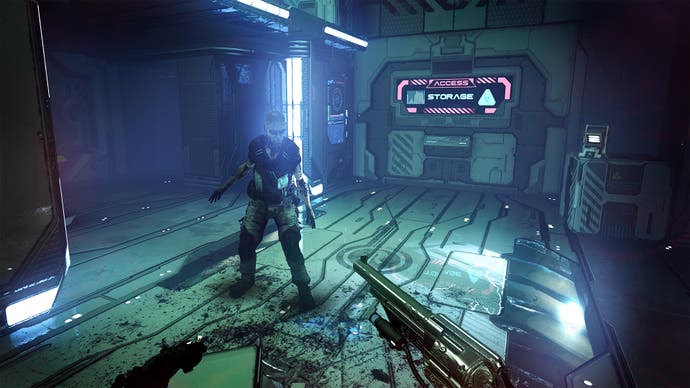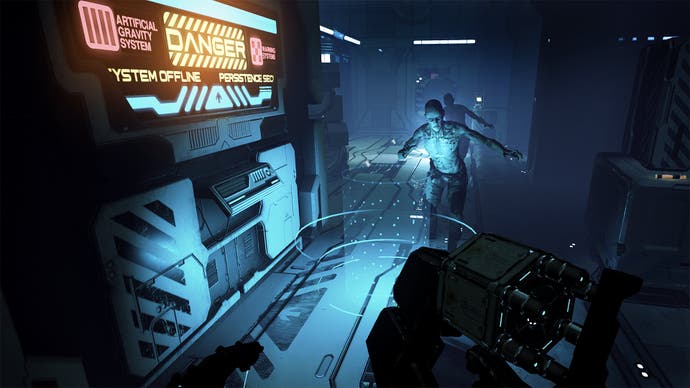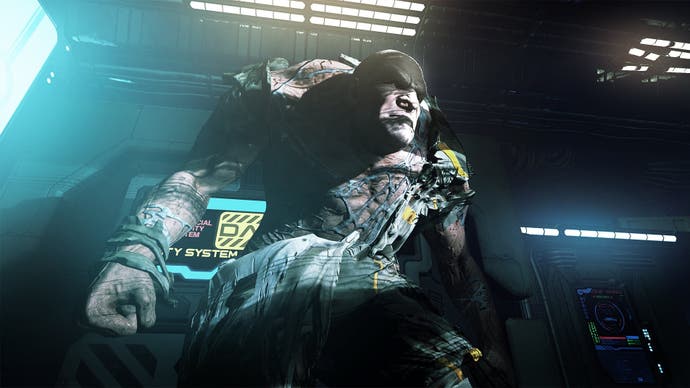VR makes me feel sick, but The Persistence does all it can to help
Keep it down.
I'm a VR sceptic. If you've read my reporting on it, you'll probably have picked that up. I have a lot of issues with virtual reality as it relates to video games, but chief among them is it makes some people feel sick. Some people like me.
I've tried many VR games, and they all - eventually - make me feel sick. So sick, in fact, that I have to take the headset off sharpish for fear of chucking up into my lap.
So when I found myself faced with playing The Persistence, a new PlayStation VR first-person stealth horror roguelike set on an abandoned spaceship, it's safe to say I was bricking it.
What I found was a VR game clearly built by developers who were mindful of the great VR sickness problem and had thought long and hard about how to solve it. And, while I still ended up feeling a bit queasy after around 45 minutes of play, I got the a sense that The Persistence could be one of the best VR games released.
The Persistence is a sort of Dead Space in first-person and in VR. You creep around an abandoned spaceship and try to defeat various humanoid monster types in a rock hard roguelike that proceedurally-generates levels upon each respawn. Using the DualShock controller, you move and shoot in standard FPS fashion, and, occasionally teleport around via an ability that's on a cooldown. Aiming is done by physically looking, which, if you're not into your VR games, can take some time to get used to. So far, standard first-person VR stuff.
What I like is that Firesprite provides three settings to play The Persistence: comfort, standard and snap. These are all variations on an attempt to successfully fuse typical first-person combat controls with virtual reality in a bid to help players keep their lunch down.
I started playing with comfort, thinking it would be the best option for someone who tends to feel sick quick with VR. Comfort is designed to let you play with standard first-person shooter controls but minimise any sickness, game director Stuart Tilley tells me.
What's interesting about comfort is how it tweaks standard FPS controls to minimise sickness. It does this in a number of ways. Take character rotation, which is governed by the right stick on the DualShock 4, for example. In comfort, this rotation is incredibly fast - so fast, in fact, that you can spin around in less than a second. This, you'd think, would make you feel pretty awful, but it actually helps. If you rotate slowly, your eyes perceive this movement as a rotation, which then causes your inner ear to recalibrate to balance against it. Obviously, you're not actually rotating when you're playing, so unless you've got strong VR legs, you feel sick. So, in comfort, right stick movement is incredibly fast in order to trick your eyes into thinking you're not rotating. Clever!
It's also worth noting there's no feathering here. In most first-person games, a half stick input triggers half rotate speed. That's not the case with comfort and The Persistence. The milisecond the right stick moves out of the dead zone, acceleration is full. There is no ramping in.
Nor is there any acceleration in movement. In regular FPS games, when you push the movement stick forward there's an acceleration curve as your character gets up to speed. But, Tilley says, acceleration can be a bad thing in VR because when your body perceives it, your stomach and inner ear react to compensate. The disconnect between this sensation and not actually accelerating in real life can cause people to feel sick. In The Persistence's comfort setting, you can still have your character walk slowly, but there's no acceleration.
Tilley, who worked on the Killzone series at Sony and, before that, the Battlefield series at EA, said ditching acceleration was counterintuitive to everything the developers knew about design.
"When we were working on Killzone we did a lot of work on making the character feel weighty, and part of that was that initial movement," Tilley says. "Coming from having worked on Battlefield and Killzone, that's a really cool thing to do. But as soon as you put it in VR it's like, oh my god, that's not a cool thing to do."

Where The Persistence does have acceleration is when you play it in standard setting. This one's for VR veterans as it strips out much of the anti-sickness tricks you find in comfort. You don't rotate as fast - even when fully extending the thumb stick. Couple this with acceleration and you can feather your movement. So, if you want to aim at something with the right stick, just like in a regular FPS, you can.
Eventually, I moved from comfort to snap, and found it a lot more comfortable. Here, camera rotation is locked to 90 degree turns and maximises all of the anti-sickness mechanics already in comfort. You can use the thumbstick to immediately turn 180 degrees, Resident Evil style, which is useful for when enemies attack you from behind - but this option is turned off by default.
More generally, the developers had to think very differently about FPS design making a VR game compared to a non-VR game. Take something as simple as the targeting reticile. In The Persistence, this is not a 2D image - rather, it wraps to a surface if it's placed on one. This acts as a subtle grounding, helping to orient the player in the 3D environment.
Take level design. In The Persistence, the floors of levels are entirely flat - deliberately so. There are no ramps or stairs in the game, either. "If you go downstairs it's like being on a rollercoaster, right?" Tilley explains. "So we kept the floors flat with teleport lifts to take you to sectioned floors."
One of the more interesting anti-sickness tricks the developers use is a vignette. Here, the sides of the screen fade to black as you rotate and move, then the black borders fade away as you stop moving. This has to do with movement in the peripheral vision, and the way it can make some people nauseous. (You can extend these black borders to go quite a long way toward the middle of the screen in the settings.)
And what about damage? In most games, when you're hit by enemies you feel it through various visual techniques such as camera shake and feedback. But, taking control of the camera away from the player in VR is a cardinal sin. To combat this, Firesprite rotates the camera when you take damage, but it does this in just one frame. It's an instant snap, rather than an actual movement. And then the camera snaps back again. This effect is similar to the incredibly fast rotation mentioned earlier. "It's weird, but your brain doesn't quite perceive it as moving," Tilley says. "It's almost like you've teleported here and back again. It's so quick, it really feels like you've been hit, but doesn't give you that woozy feeling."

All this work, then, has been done to try to make The Persistence as comfortable to play as possible by as many people as possible. And yet, some will feel sick from it. Playing comfort, I felt sick, then had to switch to snap, which felt a lot better but, perhaps inevitably, eventually made me feel sick too.
To its credit, Firesprite has done a huge amount of testing to see how well its anti-sickness mechanics go down. Tilley says 80 to 85 per cent of people who've played The Persistence in standard, which is aimed at VR veterans looking for as pure an FPS control experience as possible, are okay with it. But that means 15 to 20 per cent of people succumb to nausea in standard. Tilley, though, sounds enthused. "I'm pretty happy with that because it's how we're used to playing FPS games," he says. "So, the majority of players should be able to select that and be okay, particularly if they've got a bit of experience in VR."
With comfort, around 95 per cent of players are okay with The Persistence, which means five out of 100 complain of nausea. "It's just down to biology, with a little bit of experience," Tilley reckons.
As you'd expect, Sony provides a huge amount of documentation to its VR developers, based on research the company has done. Sony makes in-development VR games go through what's called a VR consultation "to make sure you're not doing anything that would be considered crazy", Tilley says. This consultation is deliberately hard to pass. "We've done a lot of effort and research, and it took us quite a lot of effort to get through with them guys."
The VR consultation looks at some things you'd expect it to look at, such as rotation speeds and the amount of vignette, and some things you wouldn't expect it to look at, such as the colour black.
"The smearing that's a by-product of OLED displays with blacks, they think that can cause some discomfort to the player," Tilley says.
"If there are any really dark areas of the game, they can appear to be moving at you even though they're not, because of the smearing on the OLED screens. So, they ask you to cap the level of your blacks so they're not fully black - they're slightly grey. That's one of the things they're quite strict on."

Despite all the documentation, Firesprite did its own virtual reality development, even though it sometimes led the studio down the wrong path.
"We read a paper saying how humans don't actually see their own nose, but you perceive it there," Tilley says. "The theory being that in VR, if you draw a blurry nose on the screen in VR, you can use it as an anchor point and it minimises your nausea. So, we won't for a month or so with a fake nose in the game! It was kind of a bit odd. We had a technical problem as well where it was always moving one frame behind the rest of the scene as well. That was a bit of a problem. Nose lag! When it was working, we didn't see enough evidence to leave it there. It's difficult to know, but we thought better of it."
I had a good time with The Persistence. It's tense - sometimes terrifying - and as far away from the mini-game filler I so often see on VR as you could possibly want. The pitch here is that The Persistence is a proper video game for people looking for a proper video game experience. In that I think it will end up largely successful. I don't think The Persistence has all of a sudden solved the great VR sickness problem - I'm not sure any VR game can - but I appreciate the options Firesprite has made available to players to make the whole thing as comfortable as possible.



